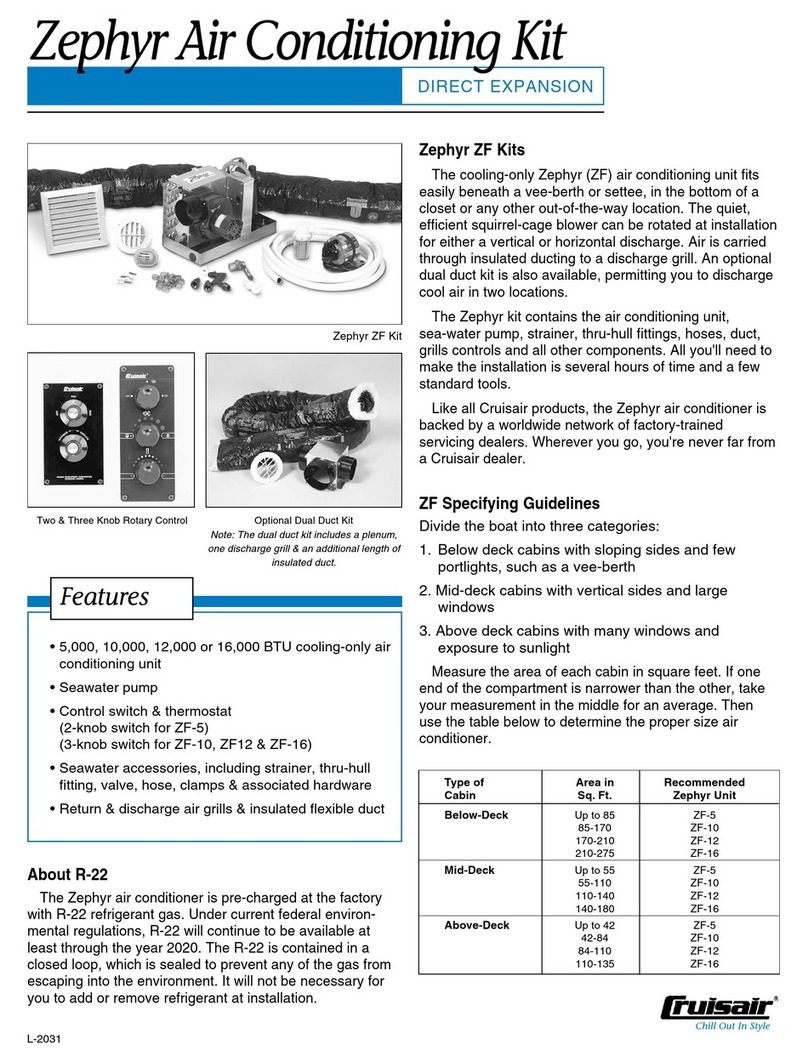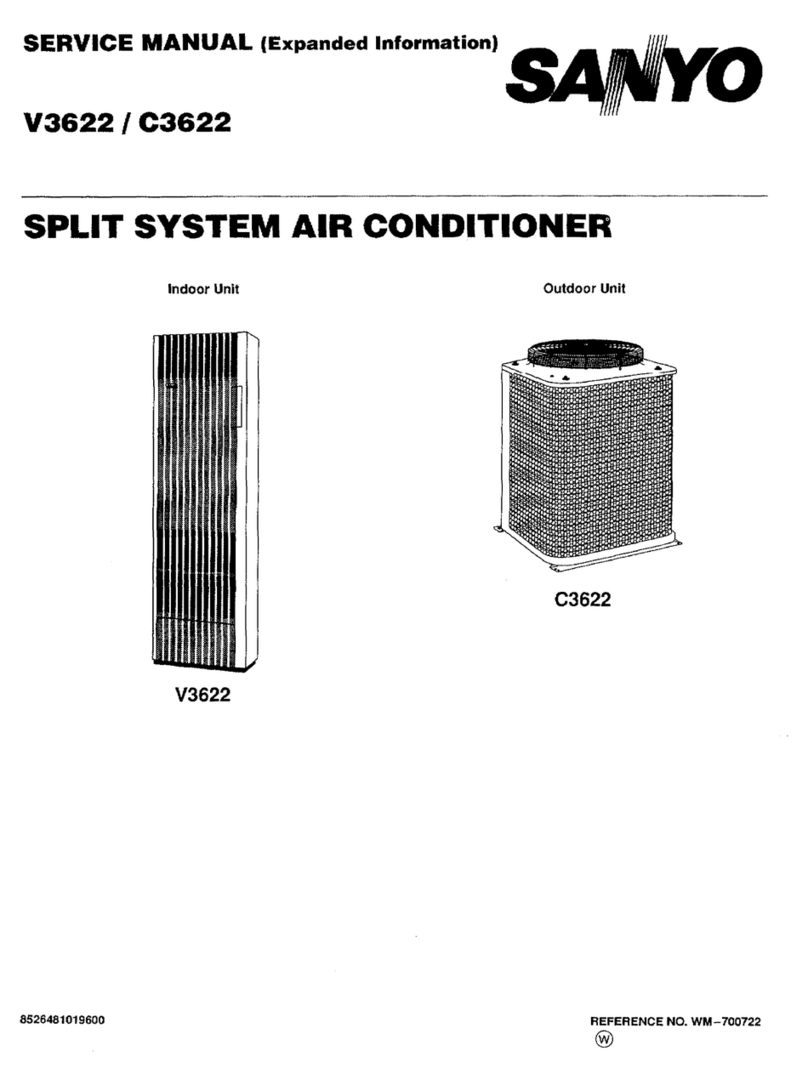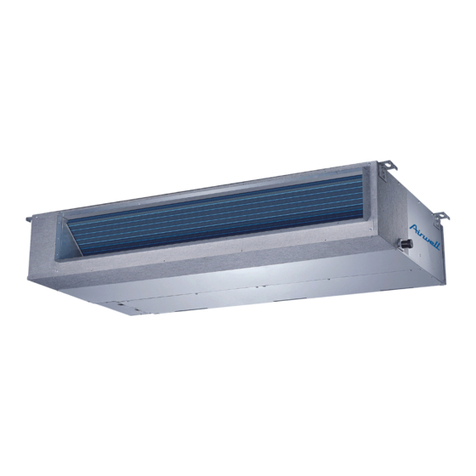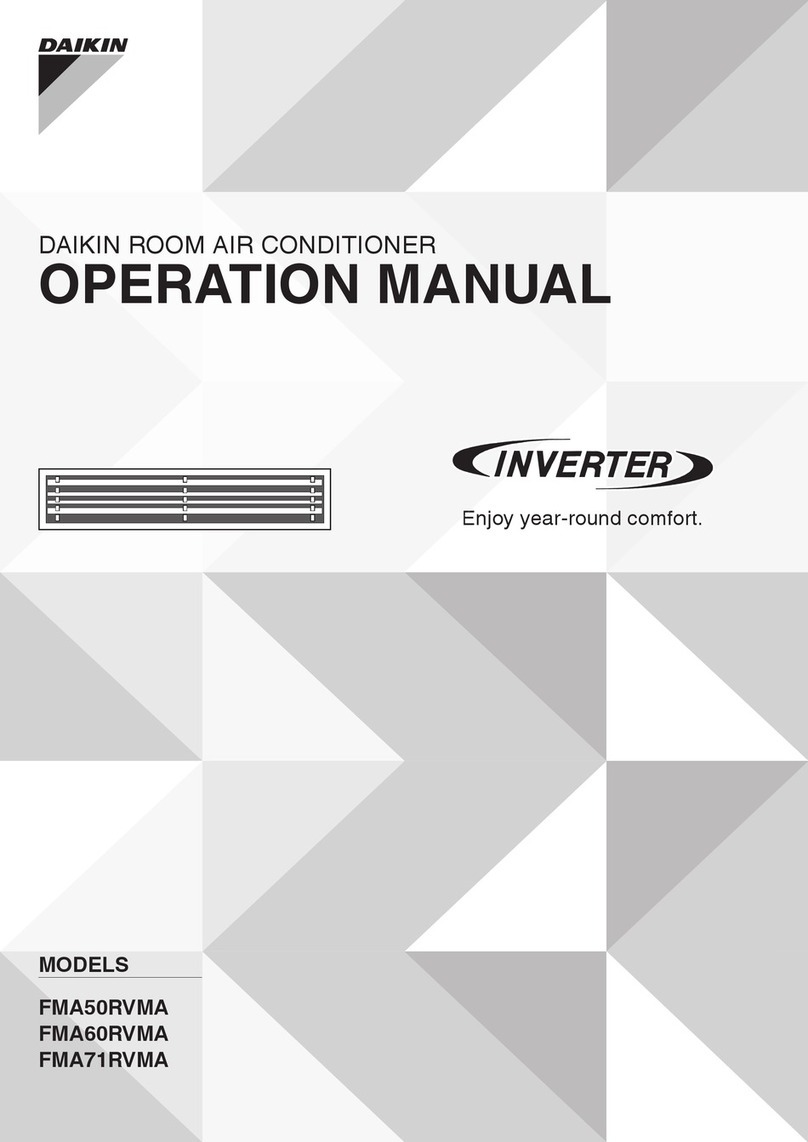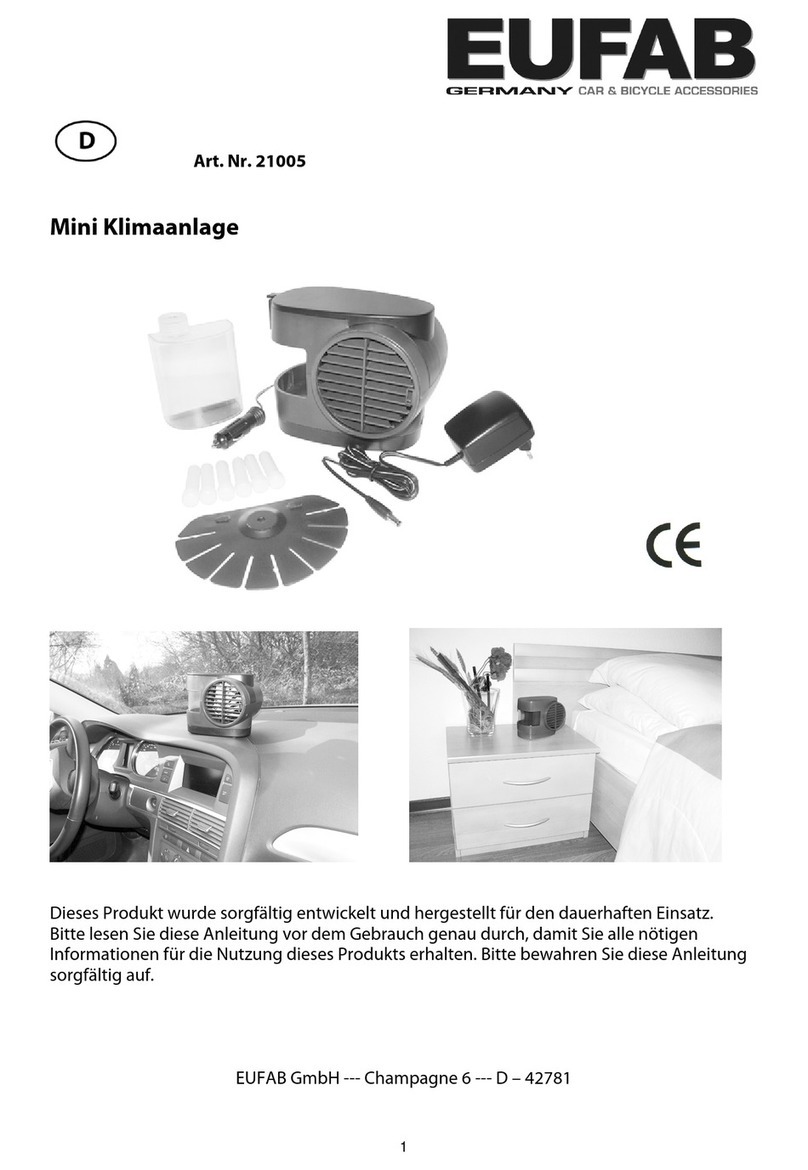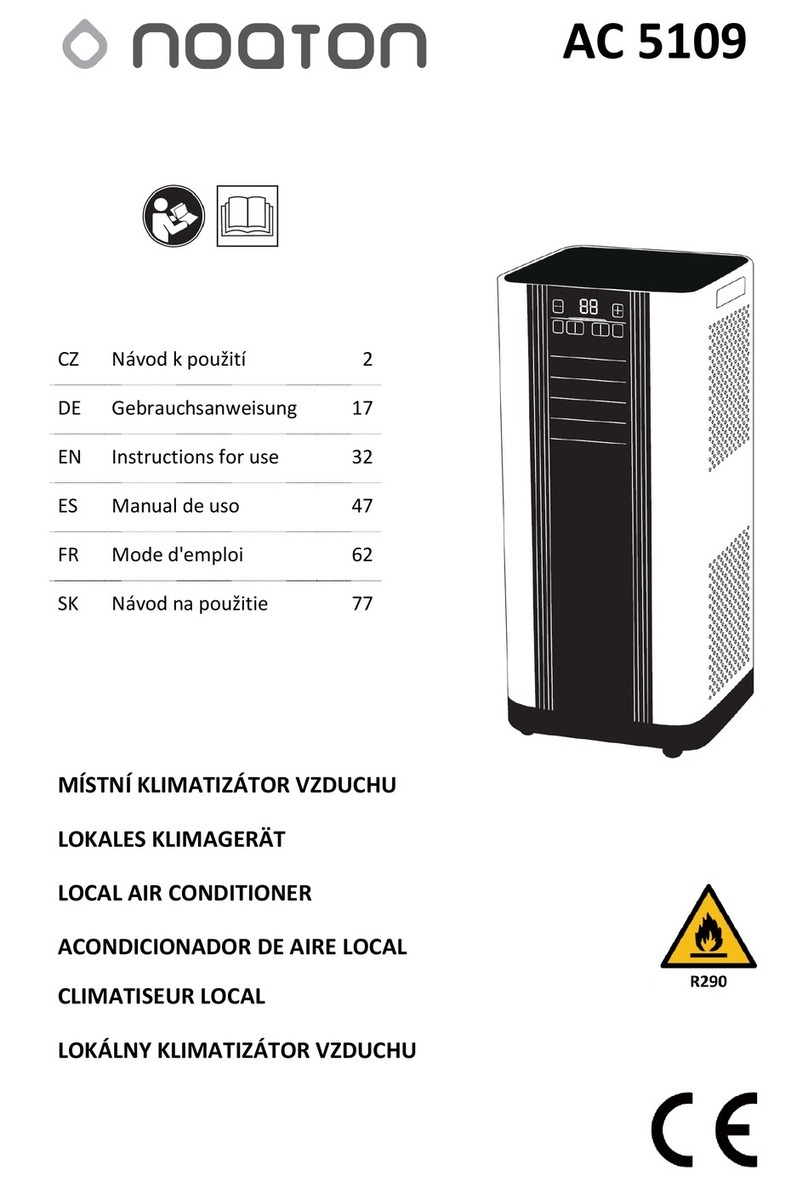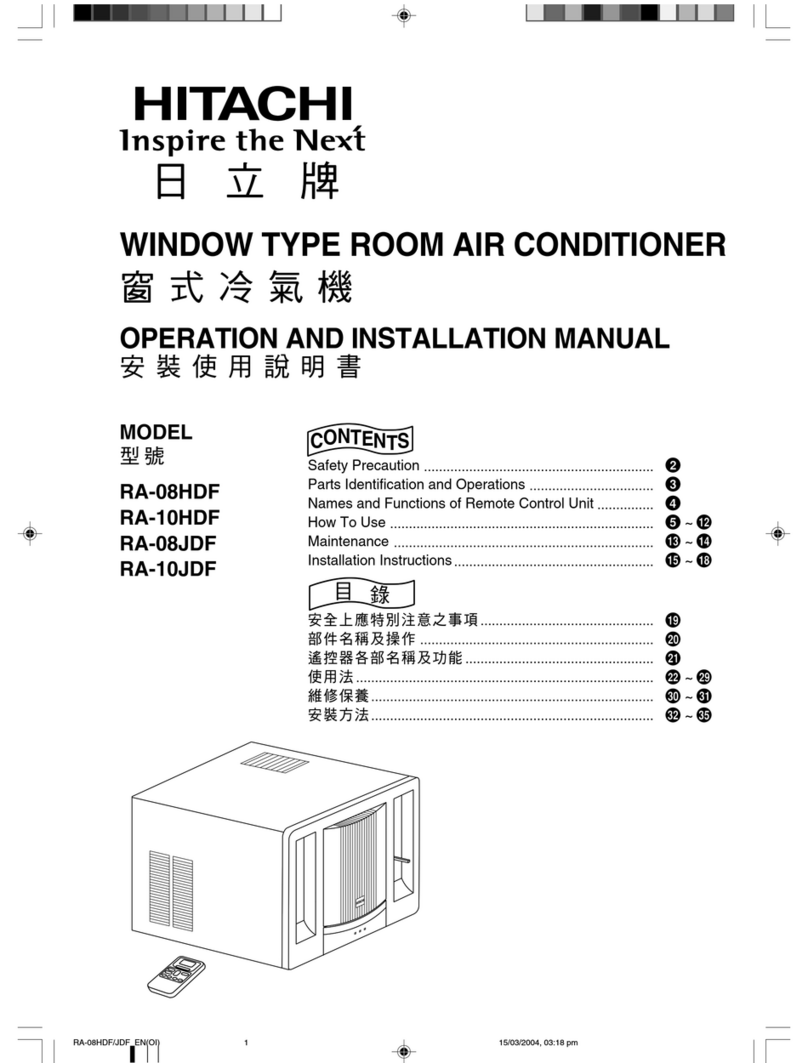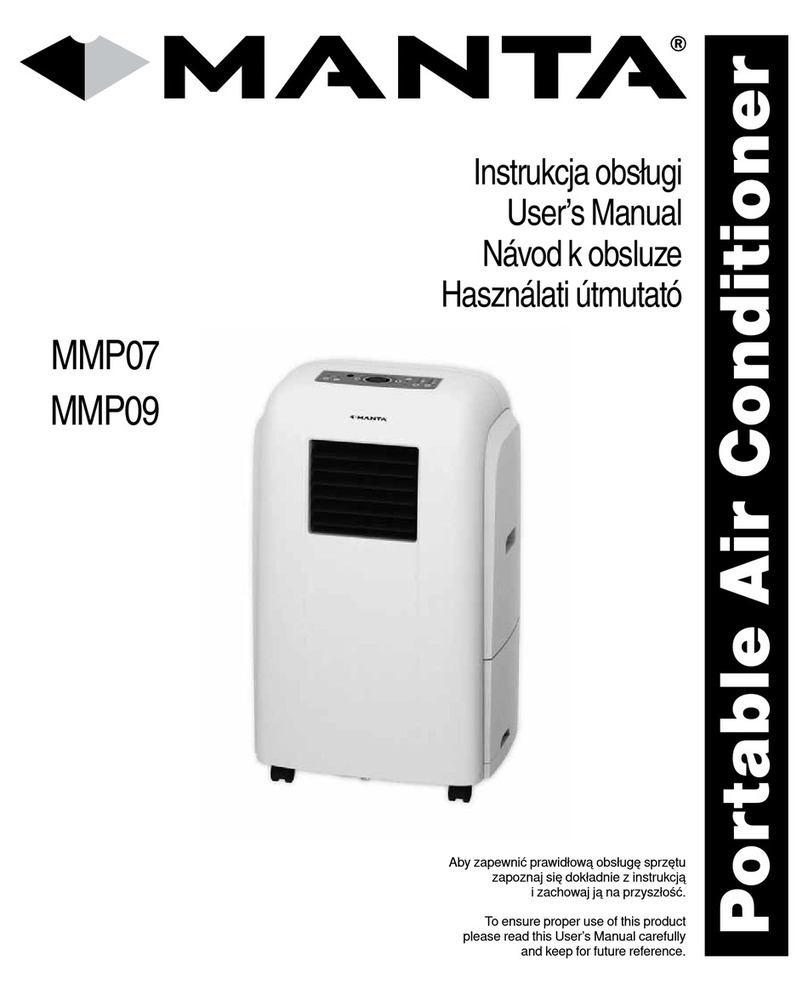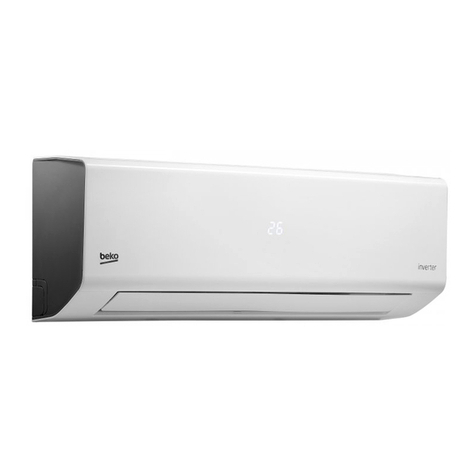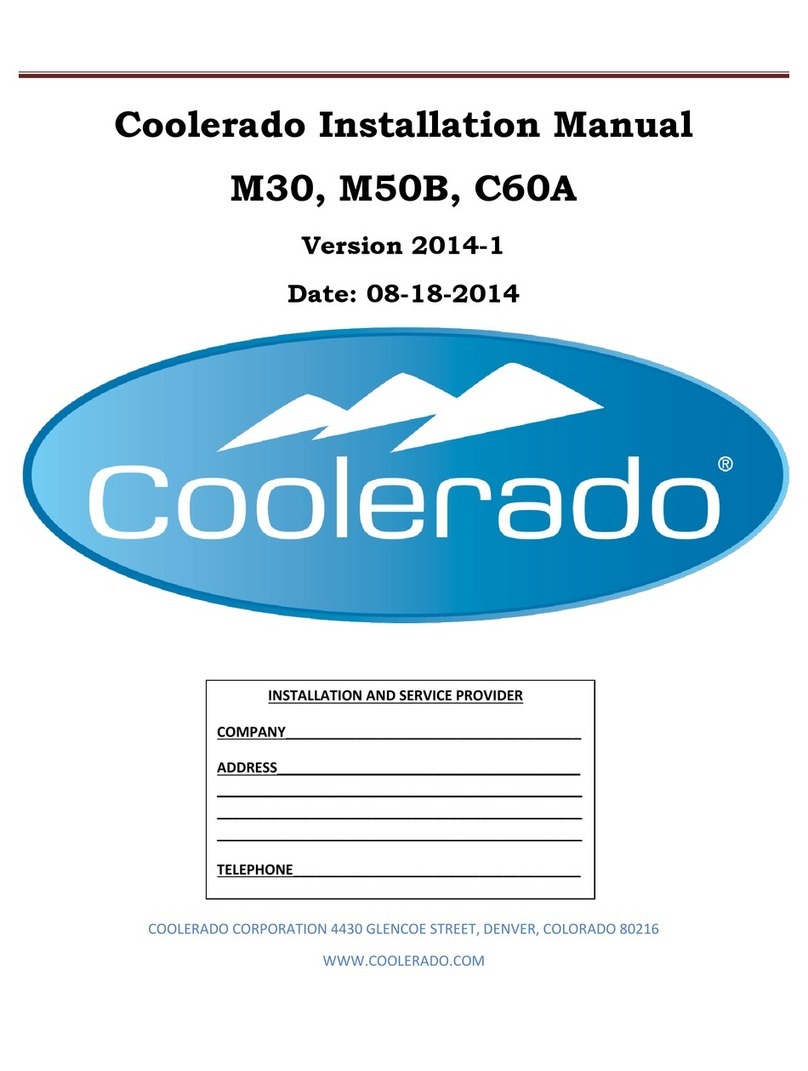Cruisair Zephyr User manual

Zephyr (ZF) & Cuddy dc
❖
INSTALLATION • OPERATION
Zephyr & Cuddy dc Self-Contained
Cooling Only A/C Kits
Revised: 5-11-07
L-2028


3❖English
L-2028
Table of Contents
Zephyr and Cuddy dc Units • Installation
Warning .............................................................................. 4
Notice ................................................................................. 4
Introduction ......................................................................... 4
Cuddy dc ............................................................................ 4
Unpacking and Inspection .................................................. 4
Safety Considerations ........................................................ 4
Placement Of System ......................................................... 5
Spacing Allowances & Unit Dimensions ............................. 5
How It Works ...................................................................... 6
Mounting Brackets .............................................................. 6
Condensate Drains ............................................................. 6
Blower Assembly ................................................................ 6
Supply & Return Air Grills
and Transition Boxes ........................................................ 6
Ducting ............................................................................... 7
Manual Control Panel Installation ....................................... 7
Electrical Connections, Grounding & Bonding for AC
Powered Zephyr ............................................................... 7
Electrical Connections, Grounding & Bonding for DC
Powered Cuddy dc .......................................................... 7
Electrical System and Wiring for DC Powered Cuddy dc .... 8
Notice and ABYC Standards: ............................................. 8
Seawater Pump and Plumbing ........................................... 8
Installation Checklist
(review prior to and after installation) ............................... 9
Zephyr and Cuddy dc Units • Operation
Operation .......................................................................... 10
Troubleshooting Guidelines .............................................. 10
Zephyr and Cuddy dc Units • Maintenance
Seawater Strainer ............................................................. 12
Condenser Coil Cleaning ................................................. 12
Return Air Filters ............................................................... 12
Winterization ..................................................................... 12
Zephyr and Cuddy dc Kits • Parts List 12
Owner’s Limited Warranty 15
Limited Warranty Periods 17
Descriptions of Figures 18
Cruisair Worldwide Service Dealer Locator 27

4❖English
L-2028 Installation
Zephyr and Cuddy dc Units • Installation
Powered Cuddy dc”. Cuddy dc owners may skip the sections
that are subtitled “for AC Powered Zephyr.”
Cuddy dc kits contain the air conditioning unit and these
three components: a Dedicated Power Module (DPM), a 2-
knob mechanical control, and the water pump. Each of these
components is connected to the a/c unit with a polarized plug.
These plugs are configured unique to each component. The
DPM is sized to run the Cuddy dc system only and should not
be used for any other appliance(s). See Figure 14 in the back
of this manual for DPM specifications
! WARNING The DPM is not ignition protected and must not
be installed in the engine compartment or in any area with
flammable or compressed gasses or liquids (see the Safety
Considerations section of this manual for more information).
Dometic recommends using a separate battery bank dedi-
cated to run the Cuddy dc. For specific instructions, please
see the two sections in this manual titled “Electrical System
and Wiring for DC Powered Cuddy dc” and “Electrical Con-
nections, Grounding & Bonding for DC Powered Cuddy dc.”
! WARNING The compressor and fan on the Cuddy dc air
conditioning unit are AC voltage components, running on
115VAC supplied by the DPM. The pump and 2-knob
mechanical control also run on 115VAC supplied by the DPM.
Once the DPM is connected to the dedicated 12VDC battery
bank, then all necessary power distribution to each of the
components is handled through the polarized plugs—truly a
“plug & play” system.
Unpacking and Inspection
When the equipment is received, all items should be carefully
checked against the packing list to ensure all cartons have
been received. Move units in the normal “up” orientation as
indicated by the arrows on each carton. Examine cartons for
shipping damage, removing the units from the cartons if
necessary. If the unit is damaged, the carrier should make the
proper notation on the delivery receipt acknowledging the
damage.
CAUTION: When unpacking and installing the control, care
must be taken not to kink or break the copper cap tube when
uncoiling the sensing bulb. The cap tube is hollow and kinking
or sharp bends will inhibit system operation.
Safety Considerations
Never install your air conditioner in the bilge or engine room
areas. Insure that the selected location is sealed from direct
access to bilge and/or engine room vapors. Do not terminate
condensate drain line within three (3) feet of any outlet of
engine or generator exhaust systems, nor in a compartment
Warning
This manual contains essential safety information concerning
the safe and proper installation and operation of Zephyr and
Cuddy dc self-contained direct expansion air conditioners. It is
very important that you read and understand the contents of
this manual thoroughly before attempting to install any
Cruisair equipment. If there are any statements in this manual
that you do not understand, contact the Dometic Environmen-
tal Applications Department (Dometic) for assistance. Phone
(804) 746-1313, Fax (804) 746-7248 (8:00am - 5:00pm
United States Eastern Time).
Notice
As of July 1, 1992, United States federal law prohibits the
intentional release of refrigerant gases into the environment,
including the R-22 refrigerant mostly used in Cruisair air
conditioning systems. Special care must be taken when
installing, charging and servicing Cruisair equipment to
prevent any loss of refrigerant.
Cruisair does not recommend the practice of using refrigerant
to purge air and moisture from the system at installation. This
formerly used practice of purging is in violation of United
States federal law.
Introduction
You have just purchased the first complete built-in marine air
conditioning system designed for self installation. We are
confident you will find the added comforts experienced in your
boat to be well worth the money spent. If, upon opening your
new system, you discover any parts are missing, contact your
dealer immediately.
Before attempting to install your new Zephyr (AC powered) or
Cuddy dc (DC powered) air conditioning system, you must
read this installation manual completely. Failure to perform
certain tasks in the proper sequence could result in an
inoperative system as well as a voided warranty.
Cuddy dc
The new Cuddy dc marine air conditioner is very similar to
the standard Zephyr but is unique in one way–it is designed to
be run on 12VDC battery power. Most of the installation,
operation and maintenance information in this manual applies
to both types of air conditioners, the AC voltage Zephyr and
the DC voltage Cuddy dc. Installation of either unit is nearly
identical with the exception of the power supply and how that
power is connected to the unit, control and pump. With that in
mind while reading this manual, please read the Installation,
Operation, and Maintenance sections titled “Zephyr and
Cuddy dc Units”, and especially the sections subtitled “for DC

5❖English
L-2028 Installation
housing an engine or generator, nor in a bilge, unless the
drain is connected properly to a sealed condensate or shower
sump pump. Failure to comply may allow bilge or engine room
vapors to mix with the air conditioners return air and contami-
nate living areas which may result in injury or death.
Consideration should be given to installing a trap in the
condensate drain line(s) so that normal discharge of conden-
sate can fill the trap and prevent the ingress of carbon
monoxide (CO) or other potentially harmful vapors.
Installation and servicing of this system can be hazardous
due to system pressure and electrical components. When
working on this equipment, always observe precautions
described in the literature, tags and labels attached to the unit.
Follow all safety codes. Wear safety glasses and work gloves
and place a fire extinguisher close to the work area. The
following is a summary of the labels on the unit:
! DANGER Electrical shock hazard. Disconnect voltage at
main panel or power source before opening any cover. Failure
to comply may result in injury or death.
! WARNING This component does not meet Federal require-
ments for ignition protection. Do not install in spaces contain-
ing gasoline engines, tanks, LPG/CPG cylinders, regulators,
valves or fuel line fittings. Failure to comply may result in injury
or death.
NOTICE This component is charged with hydrochlorofluoro-
carbon (HCFC) refrigerant R22. Effective July 1, 1992 it shall
be unlawful for any person to knowingly vent or otherwise
knowingly release any class 1 (CFC) or class 2 (HCFC)
substance as a refrigerant in a manner which permits such
substance to enter the atmosphere per the clean air act of
1990. Public law 101-549 Title IV Section 608-c. Failure to
comply may result in severe penalties, including fines and
imprisonment. Note: The Cuddy dc unit is charged with
R417A.
! WARNING To minimize the hazard of electrical shock and
personal injury, this component must be effectively grounded.
Refer to the installation guidelines for further information.
! WARNING The compressor and fan on the Cuddy dc air
conditioning unit are AC voltage components, running on
115VAC supplied by the DPM. The pump and 2-knob
mechanical control also run on 115VAC supplied by the DPM.
Disconnect voltage at main panel or power source before
opening any cover. Failure to comply may result in injury or
death.
Placement Of System
Selecting a good location for your air conditioner is the most
important part of your preparations. Be sure to consider the
size of the area you are cooling, the air distribution needs,
and the size of the unit you have chosen. Keeping in mind that
cool air has a tendency to fall, it is highly recommended that
you locate the supply air grill as high as possible in the cabin.
Figure 1a at the back of this manual shows the single duct
application and Figure 1b shows a dual duct application.
The air conditioning unit should be installed as low as
possible, but never in the bilge or engine room areas.
Insure that the selected location is sealed from direct
access to bilge and/or engine room vapors. Installing the
unit as low as possible (such as under a V-berth, dinette seat
or bottom of a locker) and ducting the supply air as high as
possible, creates an ideal air flow condition. This type of
installation will prevent short or premature cycling.
The unit should be positioned on a firm, level, horizontal
surface and the condensate drain line should run downward
from the unit to a suitable drain location. Plan all connections
which must be made including ducting, condensate drain,
seawater in and out, electrical power connections, location of
control, and seawater pump placement, to assure easy
access for routing and servicing.
Tools Required for Installation
• Screw drivers
• Pliers
• Pipe wrench
• Wire cutters/crimpers
• Drill & 7/8" bit
• Jig saw
• Duct tape
• Electrical tape
• Teflon tape
• Bedding compound to seal thru hull fittings
• Hardware to secure unit, pump, strainer, grills & control
panel
Spacing Allowances & Unit Dimensions
The following space allowances should be considered when
mounting the unit:
1. Allow a minimum of 6" (152mm) around the perimeter of
the unit in the area of the seawater and condensate drain
piping.
2. Allow a minimum of 3" (76mm) of air space in front of the
evaporator coil for the return air intake if it is adjacent to a
bulkhead.
3. Allow a minimum of 3" (76mm) of air space for the electric
blower motor ventilation. For Cuddy dc systems, allow at
least 1" (25mm) above DPM for adequate ventilation.
4. For flexible ducting connection, allow 2" (51mm) for the
duct ring, 1" (25mm) for the duct bend radius and add
diameter of the ducting to get the total clearance distance
(2" [51mm] + 1" [25mm] + duct diameter) as measured
from the blower outlet (this also applies to clearance
needed behind the supply air grill). Note that the blower
and duct ring can be positioned either vertically or
horizontally. See Figure 2 at the back of this manual.

6❖English
L-2028 Installation
These space allowances are suggested minimums. Enough
space should be allocated for installation and serviceability.
See Figure 2 at the back of this manual for space allowances
and unit dimensions.
How It Works
The air conditioning unit consists of four main components
and a refrigerant gas circulating through the system. The
BLOWER draws warm cabin air across the fins on the
EVAPORATOR where the heat from the air is transferred to
the refrigerant in the evaporator coil. As the refrigerant
evaporates from a liquid into a gas it absorbs the heat from
the cabin air. The COMPRESSOR then compresses the
refrigerant gas and pumps it through the outer tube in the
CONDENSER COIL. The seawater pump circulates cool
seawater through the inner tube in the condenser coil, this
cools the refrigerant in the outer tube and condenses it from a
gas into a liquid. The heat from the refrigerant is exchanged to
the seawater and discharged overboard. The liquid refrigerant
is then passed through the EVAPORATOR COIL and the
cycle repeats. Removing heat from the cabin air lowers its
temperature. The cooled air is blown through the ducting and
out the supply air grill(s). See Figure 3 at the back of this
manual for component identification.
Mounting Brackets
The air conditioning unit is supplied with a base pan that also
serves as a condensate pan. Mounting clip brackets and
screws (4) are provided to secure the base pan onto a flat,
horizontal surface. See Figure 4 at the back of this manual.
Condensate Drains
The condensate drain pan is 1¾" high with two drain loca-
tions. During conditions of high humidity, condensate may be
produced at a rate of approximately ½gallon (1.9 liters) per
hour. With this in mind, it is important to route condensate
drains downward to a sump pump. It is not recommended to
route condensate drains to the bilge. After the condensate
drain installation is complete, test the installation by pouring a
quart of water into the pan and checking for good flow.
For installation of the condensate drain (refer to Figure 5 at
the back of this manual):
1. Remove the aft facing watertight plug from the base pan
of the air conditioning unit.
2. Slip the solid washer and the liquid-seal washer onto the
PVC fitting in that order.
3. Connect the fitting through the exposed hole in the base
pan with the locking nut.
4. Securely tighten with two (2) wrenches to provide a
proper seal.
5. Attach a 5/8" (16mm) I.D. reinforced hose to the hose
barb and secure with stainless steel hose clamps.
6. Install the condensate drain hose downhill from the unit
and aft to a sump - hose should have a trap.
7. Two drain fittings may be used and the hoses teed
together provided there is a minimum 2" (51mm) drop
from the bottom of the base pan to the tee connection.
Note:
Do not terminate condensate drain line within 3 feet (91cm) of
any outlet of engine or generator exhaust systems, nor in a
compartment housing an engine or generator, nor in a bilge,
unless the drain is connected properly to a sealed conden-
sate or shower sump pump.
Blower Assembly
Horizontal or vertical supply air discharge may be acheived by
rotating the blower. Its design allows the blower to be rotated
by removing the screws holding the blower plate to the
evaporator coil shroud. Rotate the blower to allow the most
direct flow of air to the supply air grill. To rotate the 10-16K
blowers, remove the two plastic plugs for access to the
mounting screws.
Supply & Return Air Grills
and Transition Boxes
As previously indicated, install the supply air grille(s) as high
as possible and the return air grille as low and close to the air
conditioning unit as possible to insure direct uninterrupted
airflow to the evaporator. In no instance should the supply are
grille discharge be directed towards the return air grille, as this
will cause the system to short cycle.
The cut out for the 3" (76mm) round supply air grille for the
3.5K unit is 3" (76mm) in diameter and the flange is 3
7
/
8
"
(99mm) in diameter. The cut out for the 4" (102mm) round
supply air grille for the 5K unit is 4" (102mm) in diameter and
the flange is 5½" (140mm) in diameter. The cut out for the
rectangular supply air transition box used with the 10 & 12K
units is 11
5
/
8
" (295mm) by 5
5
/
8
" (148 mm) and for the 16K unit
it is 13
5
/
8
" (346mm) by 5
5
/
8
" (148 mm). Connect the 6"
(152mm) or 7" (178mm) oblong duct ring to the transition box
by first placing the ring on the box and tracing the hole. Cut
the oblong hole out of the box. Secure the ring to the box with
rivets (trim ¼" [6mm] from ring flanges if necessary). Com-
pletely seal the joint between ring and box with silicone. A
minimum clearance of 3" (76mm) plus the duct diameter size
is required behind the grille for attaching the ducting (see
earlier section, “
Spacing Allowance and Unit Dimensions
”).
The cut outs for the return air grilles are as follows: 7-5/8"
(194mm) square for the 3.5K & 5K units, 11-5/8" (295mm)
square for the 10K & 12K units, and 13-5/8" (346mm) x 11-5/
8" (295mm) (width x height) for the 16K unit. The return air
grille should have a minimum of 4" (107mm) of clearance in
front of it, free from any furniture or other obstructions. The
return air filter, mounted to the front of the evaporator,

7❖English
L-2028 Installation
removes debris from the air prior to the air being drawn
across the evaporator coil and fins. Dust and lint can clog and
reduce airflow across the evaporator coil resulting in poor
performance. See the “
Maintenance
” section for filter cleaning
instructions.
Ducting
Good airflow is critical for the performance of the entire
system. It is highly dependent on the quality of the ducting
installation. The ducting should be run as straight, smooth and
taut as possible minimizing the number of 90 degree bends
(two tight 90 degree bends can reduce airflow by 25 percent).
The following is a summary of proper ducting connections:
1. Pull back the fiberglass insulation exposing the inner
mylar duct hose.
2. Slide the mylar duct hose around the mount ring until it
bottoms out.
3. Screw 3 or 4 stainless steel sheet metal screws through
the duct hose into the transition ring. Make sure to catch
the wire in the duct hose with the heads of the screws. Do
not use band clamps, as the hose will slide off.
4. Wrap duct tape around the ducting and ring joint to
prevent any air leaks.
5. Pull the insulation back up over the mylar to the ring and
tape this joint.
6. Remove excess ducting and use the same connection
method at the supply air grill.
Manual Control Panel Installation
The manual control panel should be located within cap tube
length of the air conditioning unit. The dimensions for the
2-knob panel is 3¼" (83mm) x 5½" (140mm). The cut out size
for the 2-knob panel is 2½" (64mm) wide by 4¾" (121mm) tall.
The 3-knob panel is configured either vertically or horizontally.
Dimensions for the 3-knob is 2
15
/
16
" (75mm) x 7
15
/
16
" (202mm).
The cut out size for the 3-knob panel is 2" (51mm) by
6¾"(171mm). (Refer to Figures 6 and 7 at the back of this
manual.) Once the cut out is made, carefully uncoil the copper
cap tube with return air sensor (copper bulb) and route the
control wires and cap tube through the hole and back to the
unit
using caution not to kink the cap tube
. Mount the
return air sensor into the clips provided on the evaporator coil.
If the return air sensor cannot be mounted on the evaporator
coil, mount it behind the return air grill. The sensor must be
mounted in the return air stream. Make electrical connections
according to the wiring diagrams provided. (See wiring
diagrams, Figures 8, 9, 10 and 11 at the back of this manual.)
Electrical Connections, Grounding & Bonding
for AC Powered Zephyr
All Zephyr units have a five position terminal strip mounted
inside the electric box. The terminal strip is labeled for proper
connections of the electrical supply, ground wires and pump
circuits. Wiring diagrams are provided in the electrical box and
in this manual. The correct size circuit breaker should be used
to protect the system as specified on the air conditioning unit’s
data plate label. A minimum of 12 AWG boat cable should be
used to supply power to the air conditioning unit and to the
seawater pump (see next paragraph). All connections to the
terminal strip shall be made with ring terminals supplied with
the Zephyr kit. Turn off AC (alternating current) power
supply circuit breaker before opening electrical box and
accessing the terminal strip.
Each air conditioning unit installed requires its own dedicated
circuit breaker. If there is only one air conditioning unit
installed, the seawater pump does not require a circuit
breaker; the wiring from the seawater pump is connected to
the terminal strip on the unit. (See wiring diagrams, Figures 8,
9 and 10 at the back of this manual.) A minimum of 12 AWG
boat cable should be used to extend the wires on the pump, if
necessary, using the butt slices included with the kit. If two or
more air conditioning units use the same seawater pump, the
pump wires will be connected to a pump relay panel (PRP)
which in turn has its own dedicated circuit breaker (see the
wiring diagram furnished with the PRP). Any electrical
connections in the bilge below the waterline should use heat
shrink type butt splices.
The air conditioning unit must be connected to the boat’s
bonding system to prevent corrosion due to stray electrical
current. All pumps, metallic valves and fittings in the seawater
circuit that are isolated from the air conditioning unit by PVC
or rubber hoses must be individually bonded to the boat’s
bonding system also. This will help eliminate any possibility of
corrosion due to stray current.
Note: Failure to properly ground and bond the
system will void the warranty!
Electrical Connections, Grounding & Bonding
for DC Powered Cuddy dc
All Cuddy dc units are connected by polarized plugs to the
Dedicated Power Module DPM, pump, and control (available
separately or in kit). These plugs are configured unique to
each component. Wiring diagrams and schematics are
provided in this manual (see Figure 11 at the back of this
manual). A 60 amp circuit breaker or fuse should be installed
at the positive side of the battery to protect the wires. Any
electrical connections in the bilge below the waterline should
be heat shrink type.
Turn off DC power supply circuit breaker before making
connections.
The air conditioning unit and its components must be con-
nected to the boat’s bonding system to prevent corrosion due
to stray electrical current. There is a bonding ground stud on
the Dedicated Power Module. This stud must be connected to
the vessel’s bonding stud, which is typically on the engine

8❖English
L-2028 Installation
block. This connection must be made per ABYC specifica-
tions. All pumps, metallic valves and fittings in the seawater
circuit that are isolated from the air conditioning unit by PVC
or rubber hoses must be individually bonded to the boat’s
bonding system also. This will help eliminate any possibility of
corrosion due to stray current.
Note: Failure to properly ground and bond the system will
void the warranty!
Electrical System and Wiring for DC Powered
Cuddy dc
Dometic recommends a separate set of batteries dedicated
for the Cuddy dc air conditioning system. Deep cycle AGM or
Gel Cell batteries are the best for this application. If need be,
please contact your Dometic dealer for assistance in sizing
batteries.
The Cuddy dc kit contains the Dedicated Power Module
(DPM). The DPM is meant to be used for the Cuddy dc
system only and is sized to do so (see Figure 14 at the back
of this manual for DPM specifications).
When connecting the DPM to the batteries, maintain correct
wire size as shown in the DC Wire Sizing Table (see Figure 15
at the back of this manual), keep wire runs as short as
possible, and with as few intermediate connections as
possible, to avoid unnecessary resistance or voltage drop.
See wiring diagram Figure 11 for location of customer-
installed 60 amp fuse. Use an ignition protected fuse holder if
installed in the engine compartment or in any area with
flammable or compressed gasses or liquids (see the Safety
Considerations section of this manual for more information). A
standard ABYC approved battery disconnect switch is also
recommended and should be used any time the system
needs servicing. Do not forget to maintain proper color
coding, (red = positive, black = negative) to aid in future
electrical troubleshooting. If the wires are incorrectly con-
nected (positive and negative reversed), the air conditioning
unit will not start and the DPM will be damaged.
The DPM is wired to the FAN setting on the two-knob switch
assembly and is energized only when the Cuddy dc is
running (see the Operation section of this manual). For DC
wire sizing, see Figure 15 at the back of this manual.
As batteries age, their peak voltage lowers and they dis-
charge quicker. This, of course, can affect the air conditioner
performance as well as other DC devices. The battery
condition should be maintained and monitored regularly and
weak batteries should be replaced. A battery isolator, com-
biner or selector switch will allow simultaneous charging while
preventing the discharge of a fully charged battery into a
depleted one.
Over current protection, in addition to fuse provided, must be
supplied for the ungrounded conductor at the main switch-
board, per ABYC E-9. Use a 60 amp breaker for 12 VDC
systems. This provides protection from possible short circuits.
When dockside, the Cuddy dc unit can operate against the
batteries while using the AC battery charger (50 amp min) as
a backup (most marine battery chargers will shut off when the
battery is fully charged).
Ensure that all DC electrical connections are made in
compliance with American Boat and Yacht Council (ABYC)
standards section E-9.
Notice and ABYC Standards:
Field wiring must comply with ABYC electrical standards.
Power to the unit must be within the operating voltage range
indicated on the data plate. Properly sized fuses and circuit
breakers must be installed for branch circuit protection. See
equipment rating plate for maximum size. All air conditioning
units must be effectively grounded to minimize the hazard of
electric shock and personal injury. The following standards
apply:
1. AC (alternating current) grounding (green) wire must be
provided with the AC power conductors and connected to
the ground terminal (marked “GRND”) at the AC power
input terminal block of the unit(s), per ABYC standard E-8.
2. Connections between the vessel’s AC system grounding
conductor (green wire) and the vessel’s DC (Direct
Current) negative or bonding system should be made as
part of the vessel’s wiring, per ABYC standard E-9.
3. When servicing or replacing existing equipment contain-
ing a chassis-mounted “ground” stud, the service person
or installer must check the vessel’s wiring for the exist-
ence of the connection required in item 2 above.
ABYC standards are available from:
American Boat and Yacht Council
613 Third Street, Suite 10
Annapolis, MD 21403
Phone: (410) 990-4460, Fax: (410) 990-4466
Seawater Pump and Plumbing
Several guidelines should be followed during the installation
of the seawater system. Since the circulation pump is
centrifugal and not self-priming, it must be mounted so that it
is always at least one foot below the water line regardless of
which tack the vessel is on. Pump may be mounted horizon-
tally or vertically, however the discharge must always be
above the inlet. Pump head should be rotated toward the
direction of water flow.
Install the seawater speed scoop
intake as far below the water line and as close to the keel
as possible in any application, but especially on a
sailboat, to keep the intake in the water when the boat
heels over so that air does not get into the system.
The
speed scoop intake must face forward and not be shared with
any other pump. A seawater strainer is mandatory between

9❖English
L-2028 Installation
the shut off valve (seacock) and the pump to protect the pump
from any foreign matter.
Failure to install a seawater
strainer will void the pump warranty
. The seawater system
should be installed with an upward incline from the speed
scoop & seacock, through the strainer, to the inlet of the pump
and then up to the inlet of the air conditioning unit’s condenser
coil. The discharge from the air conditioning unit should then
run to the seawater outlet thru-hull fitting which should be
located where it can be visually checked for water flow and as
close as practicable to the waterline to reduce noise. All hose
connections shall be secured by means of double/reversed
stainless steel hose clamps. Use teflon tape on all threaded
connections. The following is a summary of the seawater
system installation:
1. Install the speed scoop thru-hull inlet as close to the keel
and as far below the water line as possible, facing forward.
Bed the scoop with a marine sealant designed for
underwater use.
2. Install a bronze, full flow seacock on the speed scoop
thru-hull inlet.
3. Install a seawater strainer below the level of the pump
with access to filter.
4. Mount the pump above the strainer and at least one foot
below the waterline.
5. Connect the seacock and strainer with an uphill run of
5/8" reinforced marine grade hose.
6. Connect the discharge from the pump uphill to the bottom
inlet of the air conditioning unit’s condenser coil with 5/8"
reinforced marine grade hose. Connect the discharge
from the condenser coil to the overboard discharge thru-
hull fitting with 5/8" reinforced marine grade hose.
7. Avoid loops, high spots or the use of 90° elbows with
seawater hose (each 90° elbow is equivalent in pressure
drop to 2.5' of hose and a 90° elbow on the pump outlet is
equivalent to 20' of hose).
8. Double clamp all hose connections with stainless steel
clamps, reversing the clamps.
9. Use teflon tape on all threaded connections.
10.
Connect all metallic parts in contact with seawater to
the vessel’s bonding system including the speed
scoop inlet, strainer, pump and the air conditioner
.
Refer to Figure 12, 13a , and 13b at the back of this manual
for seawater kit installation drawings.
Installation Checklist
(review prior to and after installation)
Seawater cooling system
• Speed scoop located as far below the water line and as
close to the keel as possible
• Shut off valve and speed scoop properly sealed and tight
• Seawater pump at least one foot below water line and
securely mounted
• Strainer mounted below pump with access to filter
• Double/reversed stainless steel hose clamps on all hose
connections
• Teflon tape on all threaded connections
• Hose runs uphill from speed scoop to strainer, pump and
air conditioning unit
• Water flowing freely from overboard discharge while pump
is running
Air Conditioner Unit Mounting
• Not in engine room or bilge areas, must be sealed away
from exhaust or fumes
• Proper spacing allowed around unit
• Attached to solid level platform with four hold down clips
provided
• Condensate drain routed aft and down hill to a sealed sump
(not bilge), and should have a trap
Grills and Ducting
• Supply air grill mounted as high as possible
• Return air grill mounted as low and as close to the unit as
possible
• Return air grill mounted away from exhaust and bilge vapors
• Ducting is pulled taut, straight and properly connected with
no excess
Electrical for AC Powered Zephyr
• All butt connections on pump wire tightly crimped and heat
shrunk
• AC power source installed and grounded/bonded in
accordance with ABYC standards
• Control wires connected to terminal strip with ring
terminals
Electrical for DC Powered Cuddy dc
• All polarized plugs connected securely with an audible
“snap”
• DC power source installed and grounded/bonded
inaccordance with ABYC standards
• Bonding ground stud on Dedicated Power Module con-
nected to vessel’s bonding system per ABYC

10 ❖English
L-2028 Operation
Zephyr and Cuddy dc Units • Operation
Operation
Manual Control Panel Operation:
2-knob (2KB), 3.5-5K units; 3-knob (3KB), 10, 12, 16K
units, see figures 6 & 7.
1. Ensure seawater intake ball valve (seacock) is open.
2. Turn top (MODE) control knob to OFF.
3. Turn on air conditioning unit circuit breaker. If the seawater
pump has its own circuit breaker, turn that on too.
4. Turn top (MODE) control knob to FAN, this energizes the
fan (and the DPM in Cuddy dc systems).
5. Turn THERMOSTAT control knob to the coolest position
by rotating it fully clockwise.
6. Turn middle (FAN) control knob to highest setting
(for 3KB switch only).
7. Verify that the fan is running and that there is steady
airflow out of the supply air grill.
8. Turn top (MODE) control knob to RUN (for 2KB switch)
and ON (for 3KB switch). This will start the compressor
and seawater pump.
9. Check for a steady solid stream of seawater from the
overboard discharge.
10. To set the THERMOSTAT, allow sufficient time for the unit
to cool the area to the desired temperature. When the
area is sufficiently cooled, turn the thermostat knob slowly
toward the center position until it clicks once. The
thermostat is now set to maintain a constant temperature.
Important
Do not turn the unit off and immediately turn it back on. Wait
at least 30 seconds (2 minutes for the Cuddy dc) for system
refrigerant pressures to balance.
Troubleshooting Guidelines
Before you call for service, review this list. It may save you
time and expense. This list contains common occurrences
that are not a result of defective workmanship or materials. If
you need service after trying these procedures, call your
nearest Cruisair dealer.
Problem: System will not start.
Possible Reason/Solution
1. Air conditioner circuit breaker is off. Turn circuit breaker
on at ship’s panel.
2. Wiring at terminal strip is miswired (VAC unit only).
Check wiring diagram; correct if necessary.
3. Input line voltage is insufficient (VAC unit only). Check
power source for proper voltage. Check wiring and
terminals for proper sizes and connections.
4. Cuddy dc plugs are not connected tightly (DC unit
only). Check polarized plugs from unit to pump, power
module, and control. There should be an audible “snap”
when plugs go together.
5. Batteries are not fully charged (DC unit only). Turn
Cuddy dc unit off and charge battery bank.
6. DC power wires are incorrectly sized (DC unit only).
See the “Electrical System and Wiring for DC Powered
Cuddy dc” section of this manual. Ensure that DC power
wires are sized and connected correctly.
7. Dedicated Power Module (DPM) is in lockout mode
(DC unit only).
The DPM has a protective overload lockout feature that
will cause it to shutdown in case of a problem. When this
occurs, turn Cuddy dc off and wait 2 minutes before
turning back on. If that does not solve the problem, then
continue reading:
a) If DPM has overheated (≥167°F [75°C]) then ensure that it
has at least one inch of air space above unit for, and is in
an area that provides, proper ventilation.
b) If compressor has overheated then check water pump,
strainer and hoses. When operating properly, there should
be a steady stream of water from the overboard dis-
charge. Strainer may need cleaning. Ensure that hoses
are not kinked or restricted in some other way. Pump
should come on with the compressor when control is set
to RUN.
c) If refrigerant pressure is too high, then turning the system
off for 2 minutes should correct that by allowing pressure
to equalize. Note: Turning the Cuddy dc on and off too
quickly may cause a high-pressure shutdown. During
normal operation wait at least 2 minutes from the time
control is turned off until it is turned back on.
d) If DC voltage is too high (>16-17VDC) or too low
(<10.5VDC), then check battery bank for correct charge.
Charge batteries if need be. Note: Turn Cuddy dc off and
charge batteries for 5 minutes. Try turning Cuddy dc on
again. If it runs, then that is a good indicator the batteries
were low. Fully charge batteries at this time.
e) If there is a dead short in the wiring, then disconnect
power supply and repair wiring.
If, after trying all of the above, the fan runs, but the
compress and pump do not, then that is a good indicator
there is a problem with the compressor and/or pump.
Whereas, if the fan does not come on at this time, then
that is a good indicator there is a problem with the fan or
the DPM. Either way, call for a service technician – please
see listing in back of this manual.

11 ❖English
L-2028 Operation
Problem: No cooling.
Possible Reason/Solution
1. Selector knob may not be in “cool” position. Reset
selector knob.
2. Temperature set point is above ambient temperature.
Lower temperature setting.
3. Obstructed water flow. Clean seawater strainer. Check
for good steady flow from overboard discharge.
4. Pump may be air locked. Remove hose from pump
discharge to purge air from line.
5. Coil iced. See below.
Problem: Coil iced.
Possible Reason/Solution
1. Thermostat set point is too low. Check setting on
temperature knob. If setting is extreme for conditions,
raise set point.
2. Improper air flow. Clean return air filter or remove
obstructions from return air stream. Check for crushed or
restricted ducting. Ducting run must be as straight as
possible; remove any excess ducting.
Problem: Short cycling compressor.
Possible Reason/Solution
1. Cold supply air returning directly to return air grill.
Redirect supply air so that it is not directed into the return
air stream.
Problem: System runs continuously.
Possible Reason/Solution
1. Port hole or hatch open. Close all port holes and
hatches.
2. Thermostat setting is excessive for conditions. Raise
thermostat setting to cycle compressor.

12 ❖English
L-2028 Maintenance
Zephyr and Cuddy dc Units • Maintenance
Seawater Strainer
Ensure that the pump receives adequate seawater flow by
regularly cleaning the strainer basket. Periodically check the
overboard discharge for a steady stream of water. Check
seawater intake speed scoop for obstructions. Make sure
hoses are not looped, kinked or crushed.
Condenser Coil Cleaning
Coils can become fouled over a period of time due to marine
growth or scale build-up. This both obstructs water flow and
prohibits proper heat transfer. To clean coils, flush with a 5%
muriatic or hydrochloric acid and fresh water solution.
Disconnect system hoses from coil and pump the solution
through until clean. Rinse with fresh water and reconnect
hoses. Follow manufacturer’s safety guidelines for all cleaning
solutions.
Return Air Filters
Check the return air filter about once a month and clean as
necessary. To clean the filter, remove it from the unit, rinse
with water, air dry and reinstall.
Winterization
There are several methods of winterization, some of which
work better than others. The four various methods employed
using a 50/50 non-polluting biodegradable anti-freeze/water
solution are:
1. Pumping of anti-freeze solution into the overboard thru-
hull fitting, and discharging through the intake thru-hull
fitting.
2. Use of the seawater pump to pump anti-freeze solution
through the system and discharging through the over-
board thru-hull fitting. Close seacock, remove hose from
strainer discharge, raise hose above pump (so pump
does not lose its prime) and pour in anti-freeze solution.
Pump solution through system. The strainer and hose to
seacock will also need to be drained of water.
3. Use of pressurized air injected at the overboard discharge
fitting and the water being discharged through the
seawater intake fitting.
4. Use of pressurized air to force water from the intake
through the overboard discharge.
Note:
Collect all discharged liquids and recycle or dispose of in a
proper manner.
Any method that causes the anti-freeze solution to flow
downward is the method of choice. By this means, the anti-
freeze solution will displace any water trapped and eliminate
the possibility of freezing in hidden areas.
In addition, since the seawater pump utilizes a magnetically
driven impeller, the impeller should be removed from the wet
end assembly, wiped with an alcohol solution, and stored in a
warm, dry area until commissioning takes place.

13 ❖English
L-2028
Zephyr and Cuddy dc Kits • Parts List
Cuddy dc Kits
CD3.5HV 12VDC
Condensate hose barb assembly with 4 mounting brackets included with
unit.
P/N Qty Description
222-110094 1 DPM Dedicated Power Module 12V with
MX-Plug
222-110110 1 MCP 2-KB CDH V BL MYL 12V 150L 2-Knob
Control
225-410108 1 Pump PML150 with MX150L-Plug 115V no
fittings
-OR- -OR- (kit has one pump, PML150 or PML250)
225-410112 1 Pump PML250 with MX150L-Plug 115V no
fittings
Extension Cables with Plugs for
Cuddy dc Systems
222-120200 1 3m (9.8') Cable with Plugs from Cuddy dc to
DPM
222-120201 1 6m (19.7') Cable with Plugs from Cuddy dc to
DPM
222-120202 1 3m (9.8') Cable with Plugs for Cuddy dc to
Pump
Zephyr ZF3.5 Kits
ZF3.5 115V
Condensate hose barb assembly with 4 mounting brackets included with
unit.
P/N Qty Description
222-110087 1 ZFSA1-XB 2-Knob Control dual voltage
225-500226 1 Pump PML250 115V no fittings
Air Distribution Kits
Kits (sold separately) are for use with Cuddy dc or Zephyr 3.5K units only:
226-000301 Kit Air Distribution Kit - Black (includes next 3 items)
333437 1 3" Round Plastic Supply Air Grill, Euro, Black
217-000773 1 8x8TRAF Alum Return Air Grill w/Filter, Black
226-600045 10' 3" Ducting, Insulated Flexible
226-000300 Kit Air Distribution Kit - White (includes next 3
items)
333439 1 3" Round Plastic Supply Air Grill, Euro, White
217-000728 1 8x8 RAF Alum Return Air Grill w/Filter, White
226-600045 10' 3" Ducting, Insulated Flexible
Zephyr ZF5 Kits
ZF5 115V, or ZF5CK 220V/50Hz
Condensate hose barb assembly with 4 mounting brackets included with unit.
P/N Qty Description
226-600014 5' 4" Ducting, Insulated Flexible
330571 1 Grill, Circular Off White
332743 1 Grill, 8x8TRA Anodized
222-110087 1 ZFSA1-XB 2-Knob Control dual voltage
334220 1 Thru Hull, 5/8" Plastic
226-600006 25' Hose, Seawater 5/8"
335360 1 Bush, PVC Red 1/2" MPT x 1/4" FPT
335120 3 Adapt, PVC 1/2" MPT x 1/2" HB
335080 2 Adapt, PVC 1/2" FPT x 1/2" HB
225-600021 1 Strainer (w/ Bracket 1/2" FPT)
332822 PDS-250 115V Seawater Pump
-OR- 1 -OR- (kit has one pump, 115V or 220V)
332831 PDS-250C 220V Seawater Pump
369617 17 Clamp, Hose #06SS Thin
330482 1 Ball Valve 1/2" SS Hndl (Bronze)
369699 1 Strainer, Speed Scoop 1/2" Bronze
338439 3 Terminal Butt Splice 16-14 Blue
336750 6 Terminal Ring 10-12 Yellow
Zephyr ZF10 Kits
ZF10 115V, or ZF10CK 220V/50Hz
Condensate hose barb assembly with 4 mounting brackets included with
unit.
P/N Qty Description
226-600015 10' 6" Ducting, Insulated Flexible
229-800025 1 Transition Box ABS 12x6x4.5
228-700017 1 6" ABS Oblong Transition Ring
217-300131 1 12x6TV Alum Supply Air Grill
217-300125 1 12x12TRA Alum Return Air Grill
222-110088 ZFSA1-ZB 115V 3-Knob Mech. Control
-OR- 1 -OR- (kit has one control, 115V or 220V)
222-110093 ZFSA1-ZCB 220V 3-Knob Mech. Control
334220 1 Thru Hull, 5/8" Plastic
226-600006 25' Hose, Seawater 5/8"
335360 1 Bush, PVC Red 1/2" MPT x 1/4" FPT
335120 3 Adapt, PVC 1/2" MPT x 1/2" HB
335080 2 Adapt, PVC 1/2" FPT x 1/2" HB
225-600021 1 Strainer (w/ Bracket 1/2" FPT)
332822 PDS-250 115V Seawater Pump
-OR- 1 -OR- (kit has one pump, 115V or 220V)
332831 PDS-250C 220V Seawater Pump
369617 17 Clamp, Hose #06SS Thin
330482 1 Ball Valve 1/2" SS Hndl (Bronze)
369699 1 Strainer, Speed Scoop 1/2" Bronze
338439 3 Terminal Butt Splice 16-14 Blue
336750 6 Terminal Ring 10-12 Yellow
Optional Dual Duct Kit
226-600014 10' 4" Ducting Insulated Flexible
229-000029 1 Plenum Tee Box, 6", 6", 4"
339284 1 4" Plastic Grill, White

14 ❖English
L-2028
Zephyr ZF12 Kits
ZF12 115V, or ZF12CK 220V/50Hz
Condensate hose barb assembly with 4 mounting brackets included with unit.
P/N Qty Description
226-600015 10' 6" Ducting, Insulated Flexible
229-800025 1 Transition Box ABS 12x6x4.5
228-700017 1 6" ABS Oblong Transition Ring
217-300131 1 12x6TV Alum Supply Air Grill
217-300125 1 12x12TRA Alum Return Air Grill
222-110088 ZFSA1-ZB 115V 3-Knob Mech. Control
-OR- 1 -OR- (kit has one control, 115V or 220V)
222-110093 ZFSA1-ZCB 220V 3-Knob Mech. Control
334220 1 Thru Hull, 5/8" Plastic
226-600006 25' Hose, Seawater 5/8"
335360 1 Bush, PVC Red 1/2" MPT x 1/4" FPT
335120 3 Adapt, PVC 1/2" MPT x 1/2" HB
335080 2 Adapt, PVC 1/2" FPT x 1/2" HB
225-600021 1 Strainer (w/ Bracket 1/2" FPT)
332822 PDS-250 115V Seawater Pump
-OR- 1 -OR- (kit has one pump, 115V or 220V)
332831 PDS-250C 220V Seawater Pump
369617 17 Clamp, Hose #06SS Thin
330482 1 Ball Valve 1/2" SS Hndl (Bronze)
369699 1 Strainer, Speed Scoop 1/2" Bronze
338439 3 Terminal Butt Splice 16-14 Blue
336750 6 Terminal Ring 10-12 Yellow
Optional Dual Duct Kit
226-600014 10' 4" Ducting Insulated Flexible
229-000029 1 Plenum Tee Box, 6", 6", 4"
339284 1 4" Plastic Grill, White
Zephyr ZF16 Kits
ZF16 115V, or ZF16CK 220V/50Hz
Condensate hose barb assembly with 4 mounting brackets included with unit.
P/N Qty Description
226-600000 10' 7" Ducting, Insulated Flexible
229-800026 1 Transition Box ABS14x6x4.5
228-700019 1 7" ABS Oblong Transition Ring
217-300134 1 14x6TV Alum Supply Air Grill
217-000221 1 14x12TRA Alum Return Air Grill
222-110088 ZFSA1-ZB 115V 3-Knob Mech. Control
-OR- 1 -OR- (kit has one control, 115V or 220V)
222-110093 ZFSA1-ZCB 220V 3-Knob Mech. Control
334220 1 Thru Hull, 5/8" Plastic
226-600006 25' Hose, Seawater 5/8"
335120 3 Adapt, PVC 1/2" MPT x 1/2" HB
335080 2 Adapt, PVC 1/2" FPT x 1/2" HB
225-600021 1 Strainer (w/ Bracket 1/2" FPT)
300823 1 Adapt, PVC 3/4" MPT x 1/2" HB
332724 1 Coupling, PVC 3/4" FPT x 3/4" FPT
332823 PDS-500 115V Seawater Pump
-OR- 1 -OR- (kit has one pump, 115V or 220V)
332824 PDS-500C 220V Seawater Pump
369617 17 Clamp, Hose #06SS Thin
330482 1 Ball Valve 1/2" SS Hndl (Bronze)
369699 1 Strainer, Speed Scoop 1/2" Bronze
338439 3 Terminal Butt Splice 16-14 Blue
336750 6 Terminal Ring 10-12 Yellow
Optional Dual Duct Kit
226-600014 10' 4" Ducting Insulated Flexible
229-800428 1 Plenum Tee Box, 7", 7", 4"
339284 1 4" Plastic Grill, White

15 ❖English
Owner’s Limited Warranty
As hereinafter described, Dometic Environmental Corporation limits the duration of any implied warranty to the duration
of the underlying express warranty and also disclaims any liability for consequential or incidental damages arising from
any application, installation, use or malfunction of any warranted product.
Section I
What does the Limited Warranty cover?
Products manufactured by Dometic Environmental Corpora-
tion (Dometic) are under limited warranty to be free from
defects in workmanship or materials under normal use and
service with the obligation of Dometic under this limited
warranty being limited to replacing or repairing any
component(s) which shall disclose defects within the time
limits defined in Section III and which, upon examination by
Dometic, shall appear to the satisfaction of Dometic to be
defective or not up to specifications.
This Limited Warranty is made in lieu of all other express
warranties, obligations, or liabilities on the part of
Dometic. In addition, Dometic shall not be responsible
for any incidental or consequential damages.
In those
instances in which a cash refund is made, such refund shall
effect the cancellation of the contract of sale without reserva-
tion of rights on the part of the purchaser. Such refund shall
constitute full and final satisfaction of all claims which
purchaser has or may have against Dometic due to any
actual or alleged breach of warranty, either express or
implied, including, without limitation, any implied
warranty of merchantability or fitness for a particular
purpose. Some states do not allow the exclusion or limita-
tion of incidental or consequential damages so the above
limitation may not apply to you. The terms and conditions of
this warranty shall be governed by the laws of the Common-
wealth of Virginia.
The Dealer is not an agent for Dometic except for the
purpose of administering the above warranty to the extent
herein provided, and Dometic does not authorize the dealer
or any other person to assume for Dometic any liability in
connection with such warranty, or any liability or expense
incurred in the replacement or repair of its products other
than those expressly authorized herein. Dometic shall not be
responsible for any liability or expense except as is specifi-
cally authorized and provided in this section.
Dometic reserves the right to improve its products through
changes in design or material without being obligated to
incorporate such changes in products of prior manufacture,
and to make changes at any time in design, materials, or
part of units of any one year's model, without obligation or
liability to owners of units of the same year's model of prior
manufacture.
This warranty gives you, the purchaser, specific legal rights,
and you may also have other rights which vary from state to
state. You also have implied warranty rights, including an
implied warranty of merchantability, which means that your
product must be fit for the ordinary purposes for which such
goods are used.
The duration of any implied warranty
rights is limited to the duration of the express warranty
as found in Section III.
Some states do not allow limitations
on how long an implied warranty lasts, so the above limita-
tion may not apply to you.
Section II
What does this Limited Warranty not cover?
This Warranty Shall Not Apply to:
1. Failures resulting from improper installation or use
contrary to instructions.
2. Failures resulting from abuse, misuse, accident, fire, or
submergence.
3. Any part manufactured by Dometic which shall have
been altered so as to impair its original characteristics.
4. Any parts which fail as a result of misuse, improper
application or improper installation.
5. Items not manufactured by Dometic, i.e., items which are
purchased from another manufacturer and supplied as
received by Dometic without alteration or modification
except as any part of an Dometic-manufactured unit or
component.
6. Components or parts used by or applied by the pur-
chaser as an integral part of products not manufactured
by Dometic.
7. Warranty does not cover damage to components that
comprise a Custom Wrapped Box Evaporator refrigera-
tion system (aka: catch boxes, fish boxes, etc.) when the
box is installed in such a way that the customer can
move it. These damages may include, but are not limited
to: crimped refrigerant linesets (copper tubing or flexible
linesets), refrigerant leaks, moisture ingression into the
refrigeration system, subsequent damage to condensing
unit from being operated with low refrigerant charge or
moisture in the system, broken refrigerant connections,
broken thermostat sensors, and/or broken constant
pressure valves.
Installation and application of Dometic components is not
warranted by Dometic because Dometic has no control or
authority over the selection, location, application, or installa-
tion of these components.
Section III
What is the period of coverage?
See the Limited Warranty Periods, document # L-0694, for
the period of coverage.

16 ❖English
L-0123 Revised: 6-5-06
All Dometic components bear a data plate on which there
are model and serial numbers. The serial number is date
coded. To determine whether or not any Dometic component
is in warranty, proceed as follows:
1. Determine the manufacture date of the component from
the serial number on the data plate. If you are not familiar
with the date code, write or call the Dometic Customer
Service Department at (804)746-1313, to obtain the
manufacture date. The hours of the Customer Service
Department are 8:00 am - 5:00 pm (USA, Eastern Time
Zone) Monday through Friday excluding holidays.
2. It is possible that there might exist a considerable time
lag between the date a component is manufactured and
the date it is put in service. In such instances, the date of
manufacture could indicate that the item is out of
warranty. However, based on the date the equipment is
first put in service, the item may still be covered by the
Dometic warranty described in Section I. For proof of
date put in service, Dometic will require a copy of the bill
of sale of the Dometic equipment from the installer or
new boat dealer to the original owner.
Section IV
How do you get service? Please Read the follow-
ing Warranty Procedure.
WARRANTY PROCEDURE
If the failure of a Dometic component is determined to be
covered under the Dometic warranty and the time in service
is determined to be within the warranty time limit, the owner
has the following three options:
1. Preferred option: Have a Dometic authorized Servicing
Dealer perform the work needed. The customer should
call Dometic's Service Department for a recommenda-
tion as to the closest dealer. If the customer already
knows an authorized servicing dealer, the dealer should
be contacted directly.
2. If the customer contacts Dometic's Service Department
for a Servicing Dealer and Dometic has no one in that
particular area, Dometic will authorize the use of a local
service company and Dometic will work with the local
company to assist in any way possible.
3. The customer may send his equipment back to the
factory to have the repair work done. Dometic will make
every effort to return the equipment to the customer
within a three week time period. If the claim represents a
legitimate warranty problem, Dometic will pay the freight
both ways. Dometic prefers option one and two, if at all
possible.
The customer may contact the Dometic Service Department
at (804) 746-1313.
WARNING
Dometic Environmental Corporation (Dometic) manufacturers of Cruisair, Dometic
Auxiliary A/C, Dometic Refrigerators and Freezers, Eskimo Ice, Grunert, Marine
Air, and Sentry products, makes the following safety warnings concerning the
application, installation, use and care of its products. Although these warnings are
extensive, there may be specific hazards which may arise out of circumstances
which we have not outlined herein. Use this as a guide for developing an
awareness of potential hazards of all kinds. Such an awareness will be a key
factor in assuring your SAFETY and comfort.
ELECTRICITY - Many Dometic products operate on 115, 230 or 440 volt AC
power. Such voltages can be LETHAL; therefore, the chassis, cabinets, bases,
etc., on all components must be grounded together and connected to the vessel's
grounding system. Sparks can occur as switches, thermostats and relays open
and close in the normal operation of the equipment. Since this is the case,
ventilating blowers for the removal of hazardous fumes or vapors should be
operated at least 5 minutes before and during operation of any Dometic product or
group of Dometic products. All electrical connections must be covered and
protected so accidental contact cannot be made by persons using the equipment,
as such contact could be LETHAL.
ELECTROLYSIS - Electrical leakage of any component can cause electrolytic
deterioration (electrolysis) of thru-hull components which could result in leakage
serious enough to sink a vessel which could result in loss of life. All Dometic
components must be kept clean and dry and checked periodically for electrical
leakage. If any electrical leakage is detected, the component should be replaced
or the fault causing the leakage corrected before the component is put back into
service.
GAS - Dometic Air Conditioning and Refrigeration components utilize R-22
(Chlorodifluoromethane), R134a refrigerant (Tetrafluoroethane), R-407C (which
contains Diflouromethane [HFC-32], Pentafluoroethane [HFC125], and 1.1.1.2 -
Tetrafluoroethane [HFC134a]), R404A (R125/R143a/R134 [44%/52%/4%]), or
R417a, which are non-toxic, non-flammable gases; however, these gases contain
no oxygen and will not support life. Refrigerant gas tends to settle in the lowest
areas of the compartment. If you experience a leak, evacuate all personnel, and
ventilate area. Do not allow open flames in the area of leaks because refrigerant
gas, when burned, decomposes into other potentially LETHAL gases. Refrigerant
components operate at high pressure and no servicing should be attempted
without gloves, long-sleeved clothing and eye protection. Liquid refrigerant gas
can cause severe frost burns to the skin and eyes.
VENTILATION - To cool or heat air, Dometic Air Conditioning and Refrigeration
components are designed to move air through a heat exchanger by a blower or
propeller fan. This design necessarily produces a suction on one side of the air
handling component and a pressure on the other side. Air handling components
must be installed so that the suction-pressure action does not: (1) pressurize an
area to the extent that structural failure occurs which could cause harm to
occupants or bystanders, or (2) cause a suction or low pressure in an area where
hydrogen gas from batteries, raw fuel vapor from fuel tanks, carbon monoxide
from operating propulsion engines, power generators or heaters, methane gas
from sewage holding tanks, or any other dangerous gas or vapor could exist. If an
air handling unit is installed in such a manner that allows potentially lethal gases
or vapors to be discharged by the air handling unit into the living space, this could
result in loss of life.
Maximum protection against the introduction of dangerous gases or vapors into
living spaces can be obtained by providing living spaces which are sealed from all
other spaces by use of airtight bulkheads and decks, etc., and through the
introduction of clean air into the living space. Bear in mind that the advent of air
conditioning, whether it be for cooling or for heating, naturally leads to the practice
of closing a living space tightly. Never close all windows and doors unless
auxiliary ventilating systems, which introduce clean outside air into the living
space, are used. Always leave enough window and door openings to provide
adequate ventilation in the event potentially lethal gases or fumes should escape
from any source.
CONDENSATE - All cooling units produce water condensate when operating on
the cooling cycle. This water must be drained from the cooling unit overboard. If
condensate is allowed to drip on a wooden structure, rotting or decay and
structural failure may occur which could result in loss of life. If condensate is
allowed to drip on electrical components, deterioration of the electrical compo-
nents could result in hazardous conditions. When an air conditioning system is in
operation, condensate drains may be subjected to negative pressure. Always
locate condensate drains as far as possible from points where engine waste and
other dangerous gases are exhausted so no such dangerous gases can be drawn
into the condensate drains.
Warning
Never sleep in a closed area on a boat when any equipment, which functions as a
result of the combustion of a volatile fuel, is in operation (such as engines,
generators, power plants, or oil-fired heaters, etc.). At any time, the exhaust
system of such devices could fail, resulting in a build-up of LETHAL gases within
the closed area. Warning Revised: 6-5-06

17 ❖English
Cruisair Direct Expansion (DX)
and Modulating Systems
• New, complete system installation using any member of the
SMX family.
The warranty includes the pump.
2 year warranty including Parts and Labor
• New, complete system installation using an electro-
mechanical control (3-knob).
The warranty includes the pump.
1 year warranty including Parts and Labor
• New, complete model sold as a partial system retrofit to
an existing system.
Includes SMX family.
1 year warranty including Parts and Labor
Cruisair Tempered Water
• New, complete system installation using any member of the
SMX family.
2 year warranty including Parts and Labor
NOTE: Excludes pump which has a 1 year warranty
• New, complete model sold as a partial system retrofit to an
existing system.
Includes SMX family.
1 year warranty including Parts and Labor
Refrigerators/Freezers/Fish Boxes
The below warranty periods do not apply to systems that are
installed as described in Section II, item #7, of the Owner’s
Limited Warranty, document # L-0123.
• New installation of entire system including condensing unit,
line sets, evaporator, etc.
1 year warranty including Parts and Labor
• New complete model sold as a partial system retrofit to an
existing Cruisair system.
1 year warranty including Parts and Labor
• New installation of condensing unit only, with line sets,
evaporators, etc. done by others i.e. not Cruisair pre-
charged line sets and evaporators.
1 year warranty including parts and labor on me-
chanical and electrical parts of condensing unit only.
Ice Makers, Remote and Self-Contained
• New installation of an entire Self-Contained Ice Maker
1 year warranty including Parts and Labor, including
water pump.
• New installation of an entire Remote Ice Maker, including
condensing unit, remote display, auger unit, linesets
1 year warranty including Parts and Labor, including
water pump.
• New installation of an Remote Ice Maker Auger and
Condensing unit only, with linesets done by others i.e. not
Eskimo pre-charged linesets
1 year warranty including Parts and Labor on me-
chanical and electrical parts of the auger and con-
densing unit only.
• New complete component sold as a partial system retro-fit
to an existing Eskimo system
1 year warranty including Parts and Labor on new
component only.
Note: Use of saltwater as feedwater to make ice will void warranty
on the auger section of the unit.
Sentry Battery Chargers
• New SM and FR series installation.
2 year warranty including Parts and Labor
• New G-series installation.
1 year warranty including Parts and Labor
Replacement Parts
• Replacement parts and components
Example: A-509, 40401-30.
90 day warranty, Parts only
• Replacement Compressors for other than Tempered Water
Systems - example: R3101-16T, DX equipment - installed in
an existing Cruisair system or a competitor’s system.
1 year warranty including Parts and Labor
• Replacement compressors for Tempered Water - example:
30130-36 installed in an existing Cruisair system.
1 year warranty including Parts and Labor
• A Tempered Water compressor - example: 30130-36
installed with competitor’s equipment.
90 day warranty, Parts only
Revised: 7-18-06 L-0694
Limited Warranty Periods
Please read and keep this document with your important paperwork. Use it as a reference in the future. If you have any questions, please
contact the Dometic Environmental Corporation Service Department at (804)746-1313 for clarification.
Note: Any model or replacement part that has been installed due to a warranty failure will carry only the remainder of the original warranty. All
warranties begin when the customer takes possession of the equipment. The warranty is extended to all owners of the equipment commencing the
date the original owner takes possession of it. Proof of original purchase may be required. Replacement parts, such as filters, fuses and MOVs,
are not covered under our warranty. Fuses and MOVs are used as safety devices to protect Cruisair equipment against over-current conditions
caused by lightning or inductive switching environments. We reserve the right to change our warranty policies and procedures as well as our
warranty allowances without notice.

18 ❖English
L-2028
Fig. 1a Single Duct Installation
Fig. 1b Dual Duct Installation
Fig. 2 Spacing Allowances & Unit Dimensions for
Mounting
Fig. 3 Component Identification
Fig. 4 Mounting Bracket Drawing
Fig. 5 Condensate Drain Drawing
Fig. 6 Three-Knob Switch Assembly
Fig. 7 Two-Knob Switch Assembly
Fig. 8 Wiring Diagram of ZF3.5
Fig. 9 Wiring Diagram of ZF5
Fig. 10 Wiring Diagram of ZF10-16
Fig. 11 Wiring Diagram of Cuddy dc CD3.5HV 12VDC
Fig. 12 Seawater Pump and Plumbing Drawings
Fig. 13a Seawater Installation for ZF3.5-12
Fig. 13b Seawater Installation for ZF16
Fig. 14 Dedicated Power Module (DPM) Specs Tables for
Use With Cuddy dc Systems Only
Fig. 15 DC Wire Sizing Table
Descriptions of Figures

19 ❖English
L-2028
Fig. 1a - Typical Single Duct Installation for ZF3.5-5
Fig. 2 - Spacing Allowances & Unit Dimensions for Mounting
Fig. 1b- Typical Dual Duct Installation for ZF10-16
DIMENSIONS
Unit Capacity 3,500 BTU 5,000 BTU 10,000 BTU 12,000 BTU 16,000 BTU
(in/mm) (in/mm) (in/mm) (in/mm)
(in/mm)
A – Duct Size 3.0/76 4.0/102 6.0/152 6.0/152 7.0/178
B – Base Depth 8.0/203 8.0/203 8.4/213 8.4/213 10.3/261
C – Overall Depth 9.0/229 11.6/294 12.2/310 12.2/310 14.2/361
D – Width 15.0/381 16.0/407 19.0/483 19.0/483 20.0/508
E – Height 9.3/235 11.6/294 12.9/328 13.3/337 13.5/343

20 ❖English
L-2028
Fig. 4 - Mounting Bracket Fig. 5 - Condensate Drain
Fig. 3 - Component Identification
This manual suits for next models
1
Table of contents
Other Cruisair Air Conditioner manuals
Popular Air Conditioner manuals by other brands
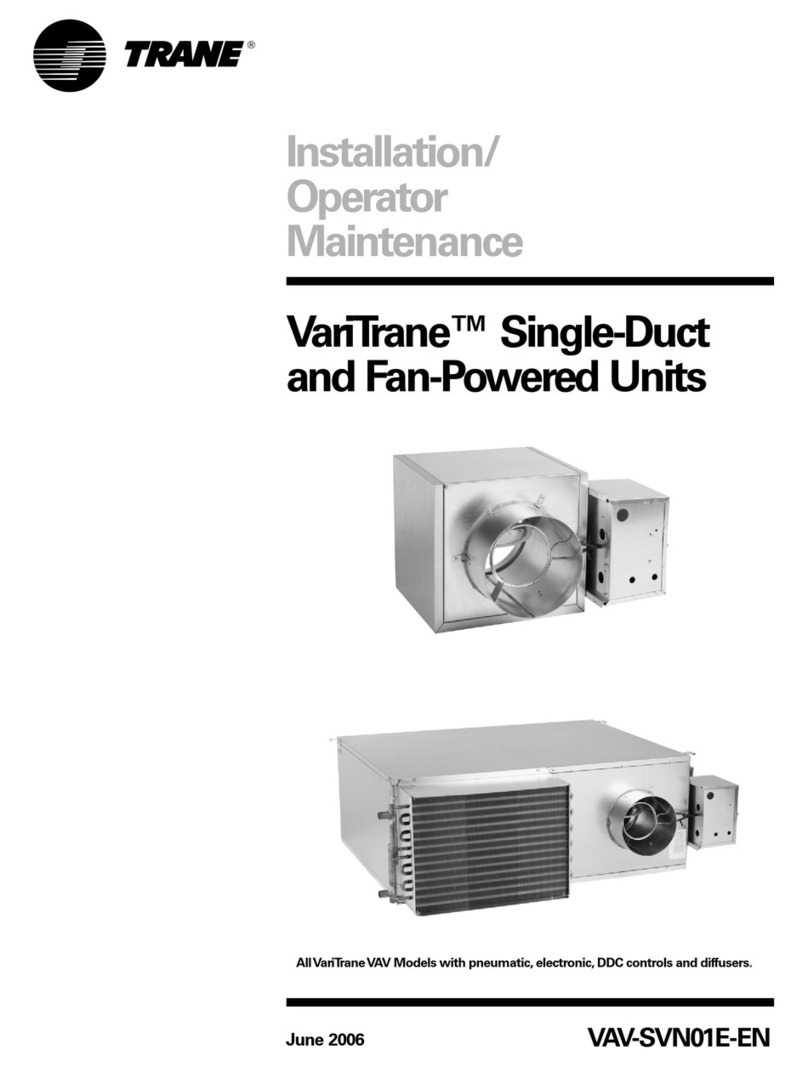
Trane
Trane VariTrane VAV Series Installation & operator's manual
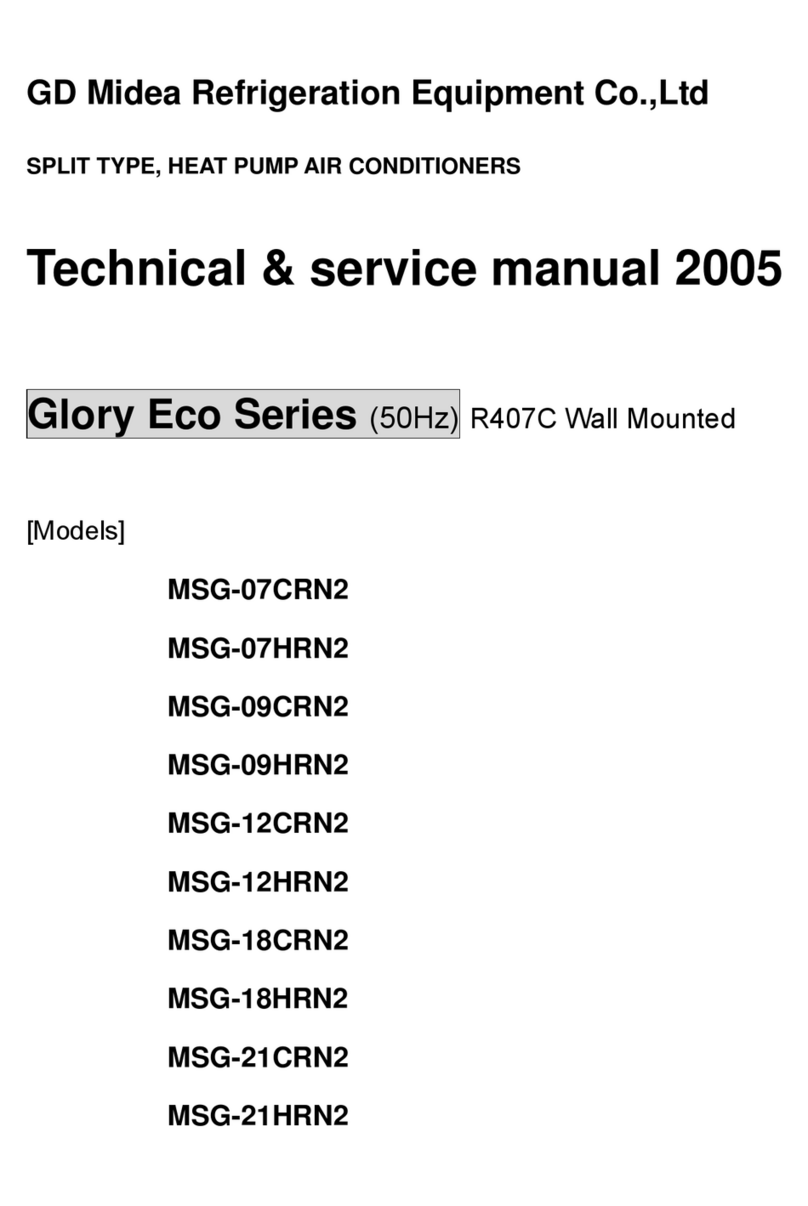
GD Midea Refrigeration Equipment
GD Midea Refrigeration Equipment MSG-18HRN2 Technical & service manual
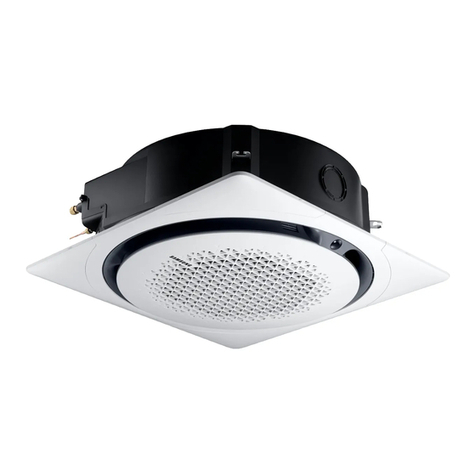
Samsung
Samsung AM KN4DCH Series installation manual

Samsung
Samsung NS 4CREA Series User & installation manual
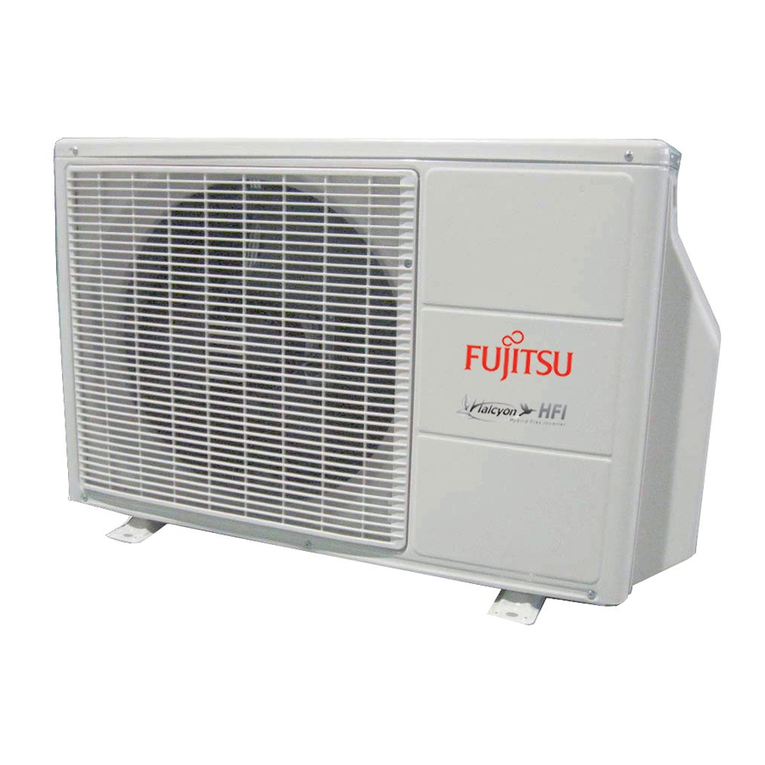
Fujitsu
Fujitsu Mini-Split manual
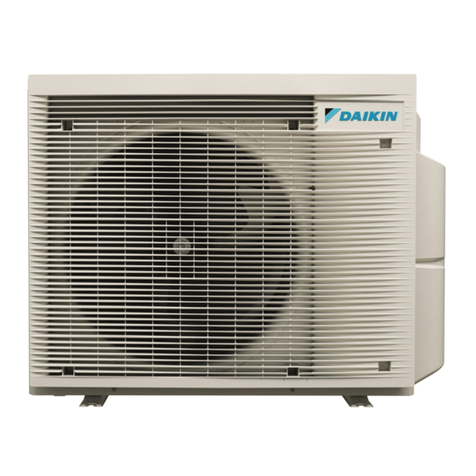
Daikin
Daikin 2MXM68A2V1B installation manual
